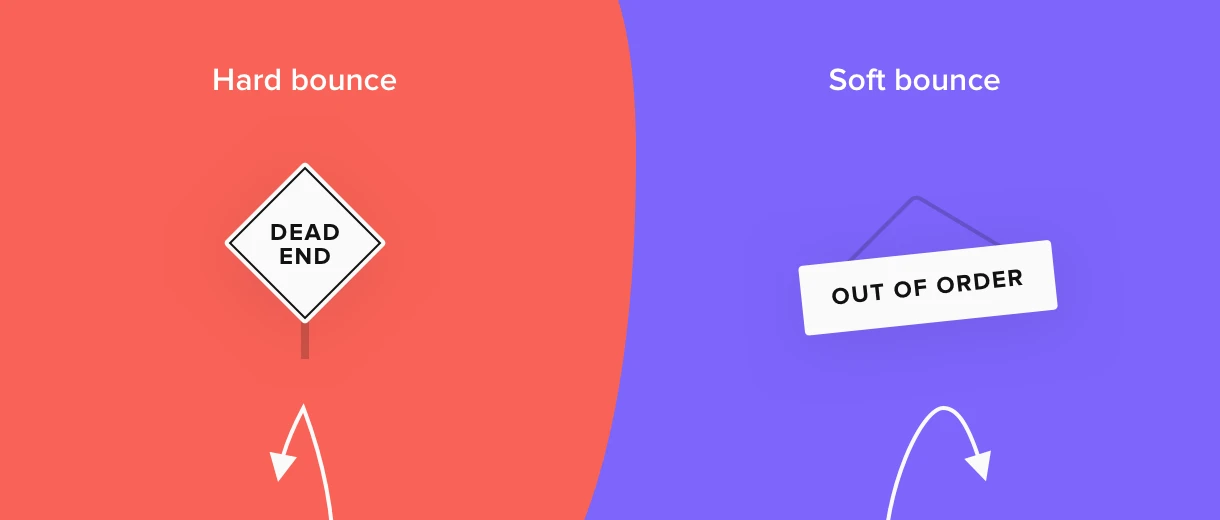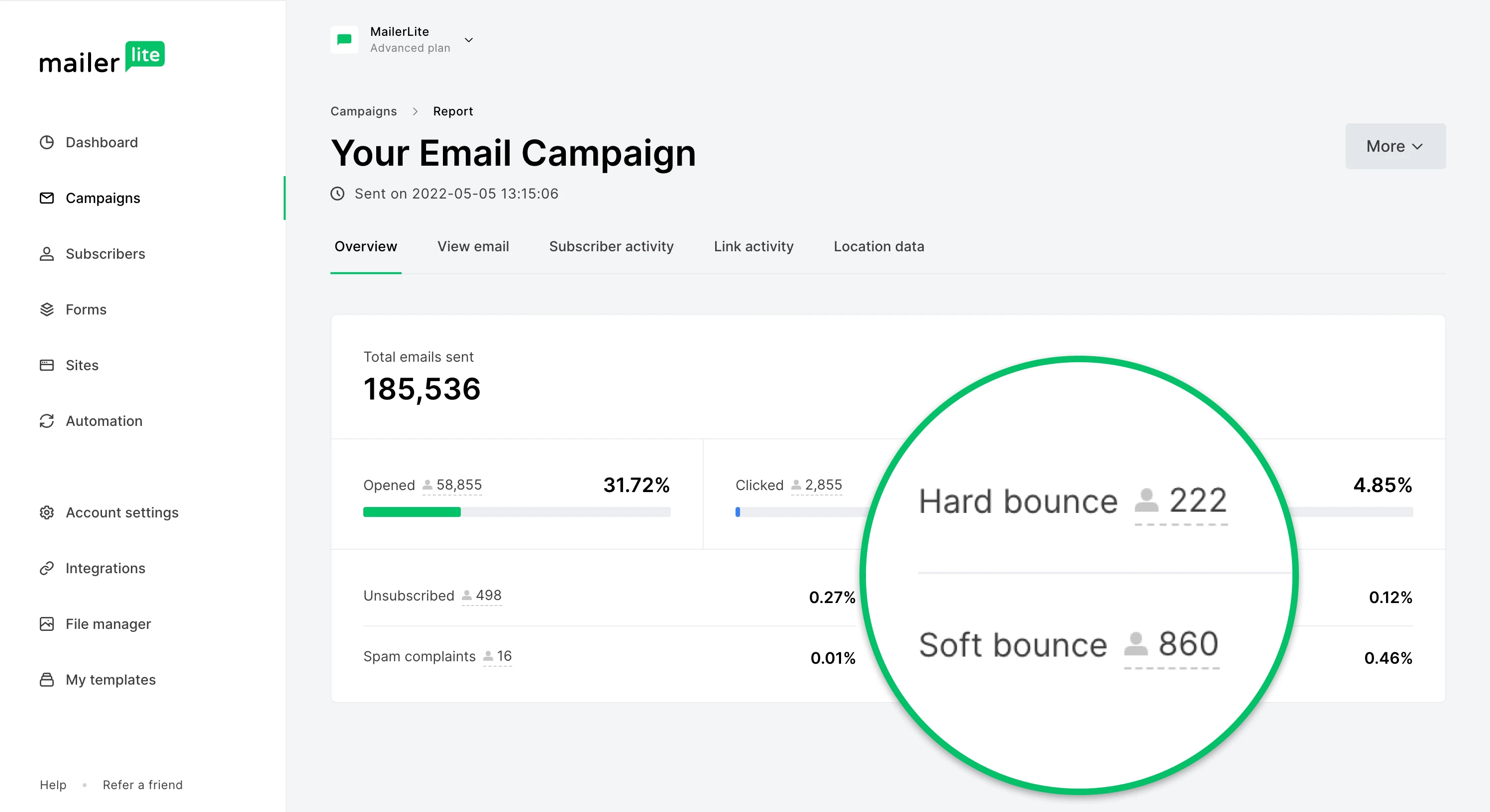Your guide to understanding email bounce rates
 Customer support team member Martynas.
Customer support team member Martynas.
Have you experienced this email marketing conundrum? You upload your subscriber list, send off the email campaign, and… your subscriber number drops.
Where did they all go? Seasoned email marketers will go straight to their campaign report to find out whether their audience has been hitting ‘Unsubscribe’. If they’ve stayed on top of their email list management, this is usually the only reason why subscribers disappear mysteriously.
Sometimes, however, to find the real culprit you need to turn to your email bounce rate. If your bounce rate is increasing, fewer subscribers are receiving your emails for one reason or another, and they may be automatically removed from your email list to an inactive list.
In this article, we’re going to walk you through:
What are email bounce rates
Average and acceptable bounce rates
The difference between soft and hard email bounce rates
Common reasons for high bounce rates
How to reduce high email bounce rate
Let’s hop to it and jump in (bounce puns intended)!
What is email bounce rate?
Now, the word ‘bounce’ might sound like fun, but the reality is a bit more annoying. In simple terms:
A bounced back email is an email that couldn't be delivered to the recipient.
Your subscriber’s server will bounce the email back for a variety of reasons, which we will explain in the next section. If you want to see your email marketing bounce rates, you can find them in your email campaign report.
Bounced back emails can seriously impact your email delivery rates. This is because a high bounce rate is detrimental to sender reputation if left unfixed.
But don’t worry. We’re going to talk you through the different types of email bounces, and then explain how you can tackle them.
Your Email Service Provider (ESP) will display your bounce rate in the form of a neat percentage. But how does this percentage come to be? It’s actually pretty simple!
To calculate bounce rate, simply take the number of bounced emails, divide this number by the total number of emails sent, then multiply by 100,
Let’s say you send a total of 80,000 emails and 156 bounce back.
(156 ÷ 80,000) x 100 = 0.20% bounce rate.
What is an acceptable email bounce rate?
It’s almost impossible to achieve a 100% deliverability rate on your email marketing campaigns, and bounces are to be expected. But, you should always aim for the lowest bounce rate possible.
Anything up to a 2% email bounce rate is the benchmark widely accepted in email marketing. If you see your reports steadily creeping up towards this number or surpassing it, it’s time to take a look at the health of your email list and take steps to optimize it. Your email bounce rate could increase for a number of reasons and is likely to do so the older your email list gets.
Average bounce rate per industry
If you’ve noticed your bounce rate is indeed higher than 2%, don’t panic! The average email bounce rate varies quite a bit from industry to industry due to the different demographics of each.
Of MailerLite customers, the average bounce rate across all industries is 0.55%, not bad at all!
Let’s break it down and see what our own data tells us about the average email marketing bounce rate per individual industry.
| Industry | Average bounce rate |
|---|---|
| Agency | 1.05% |
| Agriculture and Food Services | 0.31% |
| Animal Care and Veterinary | 1.85% |
| Architecture and Construction | 0.98% |
| Artists and Artists and Galleries | 0.39% |
| Author | 0.33% |
| Beauty and Personal Care | 0.39% |
| Blogger | 0.28% |
| Business and Finance | 0.50% |
| Computers and Electronics | 0.44% |
| Construction | 1.89% |
| Consulting | 0.58% |
| Creative Services and Agency | 0.48% |
| Daily Deals and E-coupons | 0.14% |
| E-commerce | 0.39% |
| Education and Training | 0.41% |
| Entertainment and Events | 0.36% |
| Games | 0.38% |
| Government | 0.43% |
| Health and Fitness | 0.33% |
| Hobbies | 0.24% |
| Home and Garden | 0.30% |
| Insurance | 0.63% |
| Legal | 0.73% |
| Manufacturing | 0.96% |
| Marketing and Advertising | 0.36% |
| Media and Publishing | 0.27% |
| Medical, Dental, and Healthcare | 0.60% |
| Music and Musicians | 0.63% |
| Non-profit | 0.47% |
| Online Courses and Coaching | 0.37% |
| Other | 0.40% |
| Photo and Video | 0.47% |
| Politics | 1.01% |
| Public Relations | 0.61% |
| Real Estate | 0.34% |
| Recruitment and Staffing | 0.46% |
| Religion | 0.32% |
| Restaurant | 0.73% |
| Retail | 0.40% |
| Software and Web App | 0.67% |
| Sports | 0.29% |
| Telecommunications | 0.36% |
| Travel and Transportation | 0.57% |
The difference between soft and hard email bounce rates
When we talk about email bounce rates, there are two main types that you’ll hear about: soft bounces and hard bounces.
Soft bounce rates
This refers to the rate of soft bounces your email has received. A soft bounce is a temporary issue, where the email reaches the recipient’s email server but bounces back undelivered. Your soft bounce rate could increase due to several reasons, including the recipient having a full mailbox, an offline email server, or a message file that’s too large.
Hard bounce rates
On the other hand, a hard bounce rate informs you of the number of hard bounces your email has received. A hard bounce occurs when the email can’t be delivered for permanent reasons, for example, if the address doesn't exist or the server has blocked you. The email is returned to the sender and is completely undeliverable. When this occurs, your email marketing tool will no longer send emails to those email addresses. A high hard bounce rate is problematic for email deliverability.
Why do emails bounce back?
When emails bounce back, it usually has nothing to do with your email marketing software. Your email tool will successfully send out the email, but then the subscriber’s email server rejects it for some reason. What are those reasons? We’re glad you asked.
Reasons for high soft bounce rates:
Mailbox full: Some of your subscribers’ mailboxes have limitations in terms of capacity. If this limit is reached, your email campaign will be bounced back to you.
Server timeout: The subscriber’s email server may be temporarily unavailable, overloaded, or undergoing maintenance, and any incoming messages will bounce. If this happens, you can try resending your campaign the next day.
Oversized message: This is rare, but some inboxes have sensitive filters that restrict the message size. Make sure your email isn’t overloaded with GIFs and images, or your email might bounce back.
Email account temporarily suspended: If the subscriber has not signed in for more than 365 days, or if their server has detected suspicious activity, their account could be locked temporarily. Which means… (yep, you got it)... the email will bounce.
DMARC (DKIM/SPF) requirements: Your email message might not meet the recipient mail server’s DMARC requirements for email authentication. Simply put, the server can't verify the email sender.
Reasons for high hard bounce rates:
Email address does not exist: Invalid emails are the most common reason for hard bounces. This happens when the intended recipient’s address has a typo in it, or they have disabled the address and/or switched providers.
Email message blocked by the recipient’s server: Some corporate, government and institutional domains have stricter spam filter settings.

How to improve your average email bounce rate
To put it plainly, both soft and hard bounce rates spell trouble. Here, we’ve put together a list of our top 4 best practices to help you reduce your email bounce rate.
1. Use double opt-in
When collecting subscribers, always use double opt-in forms. This is where, after signing up, the subscriber will receive a confirmation email, where they must click through to verify their email address. This extra step reduces the chances of spam email addresses ending up on your subscriber list.
Only use subscriber list-building strategies that you trust and are reliable. Purchasing email addresses is a huge mistake, and it will come back to bite you!
2. Maintain your email list hygiene
The key to avoiding bounces is to maintain a high-quality email list. Use email validation tools like Mailercheck to verify and clean your subscriber lists. When it comes to email address verification, look for tools that go beyond list validation, and provide valuable email list analysis. These insights can help you manage your list and find emails that can potentially be saved.
Sometimes, a subscriber may not have given you a valid email address. Always double-check for typos in your subscriber lists, to avoid any hard bounces.
If you transfer to another email marketing tool, make sure you only upload your active subscribers. An accumulation of invalid email addresses could severely impact your email deliverability.
To take your email list maintenance up a notch, you can choose an email verification tool that enables real-time API verification to validate new subscribers before they’re even added to your list. You’ll get no nasty surprises as your email list grows!
Last but not least, you can also ask your subscribers directly for updated information about their preferences, so you only send them the content they’re interested in.
3. Authenticate your domain
Authenticating your domain is like going through passport control before you enter a new country: the border police will want to check your credentials, before letting you through. In email marketing, an authenticated domain will legitimize your account, as Internet service providers (ISPs) like Gmail, Yahoo and Outlook can better route the origin of your email.
In addition to authenticating your domain, it's a good practice to ask your subscribers to add your email address to their inbox address book.
You can authenticate your domain directly on your dashboard if you use MailerLite. Check out our handy guide on how to authenticate my domain.
We recommend that you do not use free sender domains, such as ‘@gmail.com’. Free email domains cannot be authenticated.
4. Keep your timing consistent during email campaigns
Consistency is key. Set up an email cadence strategy so your subscribers anticipate regular and consistent contact from you. An email cadence is a combination of the number of emails you send during a certain period of time (frequency), the type of emails and the best times to send your emails.
When there is constant communication between you and your subscribers, the email service recognizes the activity as normal. In email marketing, 'normal' is a good thing.
Track your bounce rates with campaign reports

You can access your bounce rate stats in your MailerLite campaign reports. When you open up a campaign report, you will see 2 bounce sections: soft bounce and hard bounce.
With MailerLite, a soft bounced email address will remain active on your subscriber list. However, after soft bouncing for 3 consecutive times, it will be converted to hard bounce and become inactive.
MailerLite automatically moves subscribers that hard bounce into a ‘Bounced subscribers’ category, so that they don’t receive future campaigns. This means that you don’t have to remove subscribers sitting in the ‘Bounced’ tab - we do it for you. If you think that there’s been a mistake with a particular hard-bounced email, reach out and contact us and we’ll check our bounce log.
According to our Anti-Spam policy, we have the right to suspend your account if the email bounce rate is above 5%. You will be warned and asked to clean your list with an online email validation tool. This is done to ensure the quality of our servers and your sender reputation.
If you’d like to learn more, you can check out our performance reports feature, or our email campaign reports article.
It’s time for fewer bounces and more happy subscribers
Your subscriber list is the engine of your entire email marketing operation. In the same way, a car must be maintained to work properly, the health of your email marketing relies on keeping your list in great condition.
Subscriber lists with fewer bounces will give you better deliverability, higher open rates and a sender reputation that will put a smile on your face. To make your list the best it can be, remember to:
Keep your subscriber list clean, by performing an email bounce check with a validation tool
Use double opt-in to ensure you are adding valid subscribers.
Authenticate your email domain and maintain a healthy sender reputation.
Send consistent email campaigns to improve opens, and avoid any ‘spammy’ content!
Keep track of your bounce rates with the email campaign reports on your MailerLite dashboard.
You’re on your way to a bounce-free universe!
Editor's note: This post was originally published in October 2017, but it has been updated with email metrics from 2021 and new guidance on understanding soft and hard email bounces.

